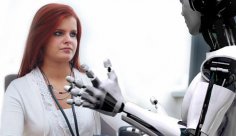
(Image credit: Figure)
A US robotics company has used artificial intelligence (AI) to make its humanoid robots walk more naturally, claiming it is just the beginning.
In the promotional video, the robot, called Figure 02 and developed by Figure, walks with a “human-like” gait, a feature they say will help the robot navigate physical space more easily.
“These initial results are impressive, but we believe they only hint at the full potential of our technology,” the company said in a blog post accompanying the announcement. “We are eager to expand our research program to address every scenario a robot might encounter in real life.”
Robots have been able to run, do somersaults, breakdance, and even beat us at chess for years. However, tasks that seem easy for humans, such as walking in a straight line, grasping objects, tying shoelaces, and interacting in social situations, have proven challenging for robots.
The problem, known as the Moravec paradox, is that computers are great at tasks that require complex calculations and large amounts of data, but they lack the real-world experience that has been honed over millions of years of evolution. This makes robots’ walking movements seem unnatural at best and, at worst, like they’re out of control.
To improve the robot's unnatural gait, Figure engineers used a learning method known as reinforcement learning, placing thousands of virtual robots in a physical simulator that recreates different landscapes, thereby improving their gait through trial and error.
By rewarding an army of virtual robots for moving naturally, they optimized their gait to be more human-like. Once that was accomplished, they uploaded the improved “Learned Natural Walking” model to the real-life Figure 02 robot. The result was an android that could move fairly naturally, with heel strikes, toe lifts, and synchronized arm movements.
Figure’s reinforcement learning approach is at the core of the California-based company’s plans to deploy robots in manufacturing. The company has already tested its humanoid robots at a BMW plant in 2024 and plans to introduce more this year. Meanwhile, Texas-based rival Apptronik is also bringing its Apollo humanoid robot to market for use in Mercedes-Benz factories by the end of 2025. Agility Robotics’ Digit will also be deployed in warehouses this year.

Ben TurnerNavigate Social LinksSenior Staff Writer
Ben Turner is a staff writer for Live Science, based in the UK. He writes about physics and astronomy, as well as other topics including technology and climate change. He graduated from University College London with a degree in particle physics before becoming a journalist. When he’s not writing, Ben enjoys reading, playing guitar, and occasionally embarrassing himself at chess.
You must verify your public display name before commenting.
Please log out and log back in. You will then be prompted to enter a display name.
Log out
Sourse: www.livescience.com





